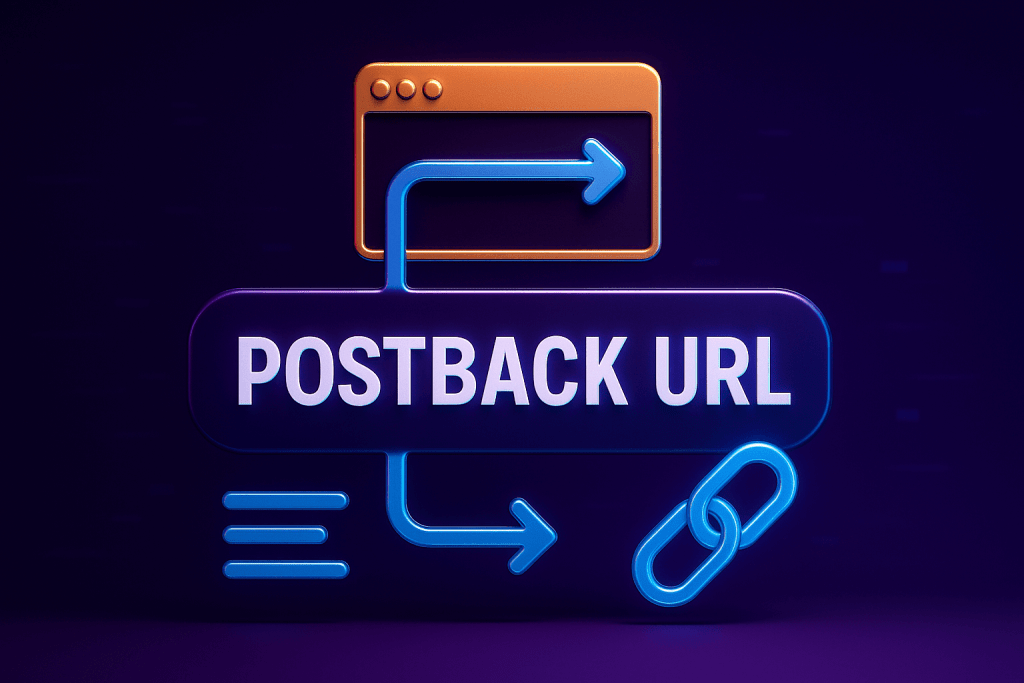Last Updated on September 25, 2025 by Caesar Fikson
Postback URL tracking can sound like something only people in IT can do… But, at NowG, server-to-server tracking has gone from nerdy footnote to board-level obsession.
The buzzword that unlocks it? “postback URL.”
Sounds trivial—just another link, right? Yet the moment you swap a flaky browser pixel for a postback, conversion data starts arriving clean, immutable, and fraud-resistant. Suddenly campaign ROAS doesn’t wobble every time Safari tightens privacy settings.
That’s why analysts, devs, and revenue-hungry affiliate managers keep grilling us: What exactly is a postback URL and why does it feel so much sturdier than the old pixel? Let’s crack it open.
Pixel vs Postback: A Quick Reality Check
Pixels ride the client side. They rely on the shopper’s browser firing a tiny image request after a sale. If the user blocks third-party cookies, runs an ad-blocker, or bounces before the confirmation page loads, your pixel never fires—and your commission vaporizes.
A postback URL sits server-to-server (S2S). The advertiser’s backend calls the affiliate tracker directly the moment a conversion or event finalizes. No browser, no JavaScript, no cookie drama. Think of it as a secure API ping that whispers, “Click ID 9f2b… just generated $120 in net revenue—mark it approved.”
How S2S Tracking Actually Flows
| Step | Actor | Action | Data Hand-Off |
|---|---|---|---|
| 1 | User | Clicks your affiliate link | Tracker generates click_id and redirects to advertiser with that token |
| 2 | Advertiser | Stores click_id in its DB or session | User journeys, eventually converts |
| 3 | Advertiser Server | Fires postback URL to tracker | /postback?click_id=9f2b&status=approved&sale=120 |
| 4 | Tracker | Matches click_id, attributes revenue | Updates dashboard, triggers payout logic |
| 5 | Affiliate | Sees real-time conversion | Optimises campaign spend |
No browser interaction after Step 1; every other handshake is pure server traffic—hard to spoof, hard to lose.
Use Cases of Postback URL Tracking
A Postback URL is a critical tool in affiliate marketing, enabling precise, server-to-server (S2S) tracking of conversions to ensure accurate attribution, real-time data sharing, and optimized campaign performance. By securely passing data between an affiliate network and an advertiser’s server, Postback URLs eliminate discrepancies and enhance transparency.

Below is a table outlining key use cases for Postback URLs in affiliate marketing, showcasing how they drive conversions in 2025.
| Use Case | Description | Benefits | Example Scenario |
|---|---|---|---|
| Accurate Conversion Tracking | Tracks user actions (e.g., purchases, sign-ups) by sending real-time data from the advertiser’s server to the affiliate network via a Postback URL. | Ensures affiliates are credited accurately, reducing disputes and improving trust. Supports complex funnels with multiple conversion points. | An affiliate drives traffic to an iGaming platform. When a user deposits funds, the Postback URL notifies the affiliate network, ensuring the affiliate is paid for the conversion. |
| Fraud Prevention | Verifies conversions server-side, bypassing client-side issues like ad blockers or cookie restrictions. | Minimizes fraudulent conversions (e.g., fake sign-ups) and ensures compliance with privacy laws like GDPR. | A finance offer tracks lead registrations. The Postback URL confirms only verified leads, filtering out bot-driven submissions. |
| Real-Time Campaign Optimization | Delivers instant conversion data, allowing affiliates to adjust campaigns dynamically based on performance metrics. | Boosts ROI by enabling quick tweaks to targeting, creatives, or traffic sources. | An affiliate running push ads for an eCommerce store uses Postback data to pause underperforming ad sets and scale high-converting ones within hours. |
| Cross-Device and Cross-Platform Tracking | Tracks conversions across devices (mobile, desktop) and platforms without relying on cookies or pixels. | Overcomes limitations of cookie-based tracking, ensuring seamless attribution in a cookieless world. | A user clicks an affiliate link on mobile but converts on desktop. The Postback URL ensures the affiliate is credited regardless of device. |
| Customized Data Sharing | Allows advertisers to pass specific parameters (e.g., transaction value, user ID) to affiliates for detailed reporting. | Enables granular insights for optimizing campaigns and tailoring strategies to high-value users. | An affiliate promoting a subscription service receives Postback data on subscription tiers, focusing efforts on users signing up for premium plans. |
| Integration with Multiple Traffic Sources | Supports integration with diverse traffic sources like push ads, native ads, or social media campaigns. | Simplifies tracking across platforms, ensuring consistent data flow for affiliates using varied channels. | An affiliate uses push ads and email campaigns for a dating app. Postback URLs unify conversion data from both sources for streamlined analysis. |
| Supporting High-Volume Campaigns | Handles large-scale campaigns by processing high volumes of conversion data efficiently and securely. | Scales with campaign growth, preventing data loss or delays in high-traffic scenarios. | A Black Friday campaign for an online retailer generates thousands of conversions daily. Postback URLs manage the data load without downtime. |
Why Postback URLs Matter in 2025?
In an era of increasing privacy regulations and the decline of third-party cookies, Postback URLs are indispensable for affiliate marketers. They provide a robust, server-side tracking solution that ensures accuracy, supports real-time optimization, and adapts to diverse use cases like iGaming, eCommerce, and lead generation. By leveraging S2S tracking, affiliates can maximize conversions, reduce fraud, and stay competitive in the fast-evolving affiliate marketing landscape.
For a deeper dive into setting up Postback URLs or optimizing them for specific campaigns, explore our full guide or consult platforms like Voluum or Affise for seamless S2S integration.
Dissecting a Real Postback URL
https://track.example.com/postback?click_id={clickid}&status={status}&payout={sale}&txn={transaction_id}&ts={timestamp}
- click_id – unique token your tracking platform minted at click time
- status –
approved,pending,rejected—crucial for clawbacks - payout – numeric value (can be zero for lead events)
- txn – advertiser’s internal order or deposit reference
- ts – Unix timestamp for chronological sanity checks
Those curly-braced macros get auto-replaced by the advertiser’s system before the call fires. Treat them like merge tags in email, but for conversions.
Global vs Offer-Specific Postbacks
| Flavor | Setup Scope | Ideal When | Caveats |
|---|---|---|---|
| Global Postback | One URL for all offers in the account | You run dozens of campaigns and don’t want to maintain a mess of endpoints | Must include an offer_id or tag so the tracker can route data accurately |
| Offer-Specific Postback | Unique URL per promotion | High-volume flagship offers where you tweak parameters or payout logic independently | Operational overhead—forget to update it and the tracker goes blind |
Seasoned affiliates often mix both: a global postback for the long tail, plus custom endpoints for VIP promos that need bespoke validation or LTV stitching.
When Postbacks Beat Pixels—Hands Down
- Mobile app installs – no browser, so JavaScript pixels can’t even load.
- Privacy-first browsers – Safari’s ITP, Firefox ETP, Brave… all throttle third-party cookies.
- High-stakes verticals – iGaming, fintech, insurance—where a single lost conversion means hundreds in missing RevShare.
- Fraud mitigation – server logs catch IP mismatches, device farms, and double fires. You can hash or HMAC the payload so bad actors can’t fake conversions.
Wondering why some still cling to pixels? Habit, mostly, plus the illusion of simplicity. But hard truth: debugging a broken JavaScript tag at 2 a.m. is never simple.
Hardened Security: More Than HTTPS
Postback URLs carry money-sensitive data; treat them like API keys.
- Hash the payload – Append
signature=sha256(click_id+secret_key)so the tracker refuses forged requests. - IP allow-lists – Only accept calls from advertiser IP ranges.
- Token authentication – Rotate tokens per advertiser; revoke on breach.
- Rate limiting – Block ping floods that could inflate conversions.
Skip these, and you’ll meet the dark side of S2S quickly—refund hell and angry finance teams.
Plug-and-Play with Leading Platforms
- Scaleo – Drop a global postback in Settings → Tracking, or override at the offer level. Built-in checksum macros (
{hash}) let you verify payload integrity without custom code. - Voluum – Uses “Traffic source postback” templates; supports dynamic tokens like
txidand automatic SSL certificates. - Everflow – Lets you chain multiple postbacks per event (handy for BI pipes).
- TUNE – Legacy powerhouse; still favored for its granular partner permissions.
- RedTrack – Rolls out privacy sandbox detection so postback fallback triggers automatically when cookies die.
Implementation rhythm seldom changes: paste the URL, map tokens, toggle on HMAC, fire a test conversion. Once you see green, tell media buyers to floor it.
Do You Even Need Pixels Anymore?
Clients ask this weekly. Short answer: keep pixels as a visual confirmation layer if you like, but never rely on them for financial truth. Think of pixels as headlights; postbacks are the engine telemetry. One shows you where you’re going, the other tells you if the car is actually moving.
Truth be told, every serious performance program that scales past a few thousand clicks a day ends up migrating to S2S. The data hygiene is addictive—absolutely addictive. After a month of 99.8 % match rates, rolling back feels like downgrading from fiber to dial-up.
When and Why to Use Postbacks Over Client-Side Tracking?
Safari’s latest privacy patch just broke three of your pixel-based funnels overnight—again. If the sound of that doesn’t raise your blood pressure, perhaps the CFO’s Slack ping will. At NowG, we ditched the “wait-and-pray” browser tag mindset ages ago because server-to-server postbacks don’t flinch when browsers get cranky. The real puzzle isn’t how postbacks work (we covered the mechanics last week); it’s knowing exactly when they become mission-critical and why clinging to client-side tracking costs more than most teams admit.
Sometimes the easiest way to see the pattern is to put the use-cases side by side, so let’s do just that.
| Scenario | Browser Pixel Fate | Postback Outcome | Strategic Payoff |
|---|---|---|---|
| iOS app install (no webview) | Tag never renders; conversion lost | Advertiser’s SDK fires S2S ping the instant the install confirms | Secure LTV attribution, unlocked UA budget |
| User runs AdBlock / Brave | Pixel blocked by default filter list | Server call ignores client settings | Restores 100 % click-to-sale visibility |
| Safari ITP or Chrome Privacy Sandbox | Third-party cookies expire in 24 h or get proton-washed | Postback tied to click_id token that lives in back-end DB | Multi-day funnels stay stitched together |
| High-stakes payout (casino VIP hits €50 K) | Pixel may time out on long cashier flow | Postback triggers when cashier API flags “approved” | No missing RevShare, no finance disputes |
| Audit / compliance (licensing board probe) | Client logs incomplete; browser cache wiped | Immutable server logs + hashed payload | Passes forensic audit without sweaty palms |
| Sophisticated fraud (device farm) | Script fires ghost pixels to inflate leads | IP-whitelisted S2S call requires signed hash | Fake conversions rejected at the gate |
Feel that?
It’s the breathing room that comes from not sweating every browser quirk.
Truth be told, the why behind postbacks boils down to four pressure points:
1. Reliability beats elegance every single quarter. Pixels look clean in the doc, yet field tests reveal a 5-15 % drop-off once ad-blockers, flaky internet, or checkout redirects enter the chat. Multiply that by a 40 % RevShare deal and you’re staring at a five-figure leak—per GEO.
2. Privacy legislation is a freight train, not a blip. GDPR, CCPA, LGPD, DMA… each chips away at client identifiers. Postbacks sidestep cookie consent entirely because the lawful basis shifts from user device to contractual data processing between partners.
3. Mobile apps own the future funnel. In-app browsers seldom allow third-party JS; the moment your offer lands inside an embedded WebView, pixels are ghosts. S2S ties install, registration, and deposit in one neat chain—even if the user never loads a thank-you page.
4. Finance teams trust server logs. When the monthly reconciliation lands, nothing soothes a skeptical accountant faster than timestamped postback receipts signed with an HMAC that matches the click ledger. You avoid “adjustments” that gnaw at morale and flow.
Let’s be frank: swapping to postbacks isn’t a weekend hobby. You’ll juggle token sync, IP allow-lists, and encrypted payloads. Yet once the pipes hum, you gain superpowers pixels can’t fake—like triggering a real-time Slack alert when a high-tier deposit clears, or letting BI tools pull raw conversion JSON straight from the tracker instead of screen-scraping dashboards at 04:00 CET.
And yes, the tech stack matters. Scaleo’s postback wizard now auto-generates hash templates and pops a health-check tile into every offer card, so non-dev colleagues spot broken callbacks before paid traffic burns. Voluum, RedTrack, and Everflow offer similar guardrails, but Scaleo folds the whole flow into three clicks, which spares me the usual Monday firefight.
Here’s the kicker: client-side tags still have a cameo role—as a graceful fallback, a visual cue for CRO heatmaps, or a redundancy layer when a partner refuses S2S. But treating pixels as your single source of truth? That approach is a gamble from the past, one that quietly drains budgets while going unnoticed.
Are you ready to move your attribution backbone off shaky browser sand and onto rock-solid postbacks? Will the upcoming Safari update be the decisive factor? The clock, as always, is ticking.
Ready to Track Like the Pros?
You can hand-code S2S endpoints and babysit logs—or plug into a platform that already solved the puzzle.




[…] Postback URLs connect to Scaleo or any other tracker of your choice, but the actual data is stored within PAM. If your RevShare relies on net gaming revenue, it is important to ensure that the operator’s PAM accurately calculates bonuses and cashback. Bad math = negative carry, itches you can’t scratch. Worse, API-first PAMs now expose live cohort values—affiliates with the keys can retarget or upsell high-rollers before they cool. That transparency slices optimization cycles from days to minutes. […]
[…] (S2S) postback – the merchant’s backend calls the network’s endpoint with a secure click ID once payment […]
[…] multi-event postback setup lets partners watch click-to-FTD latency in under sixty seconds, which means they can tweak […]
[…] with real-time attribution tools feel exciting until an API update breaks your postback and entire cohorts go untracked. Monitor with automated heartbeat pings; set alerts for revenue […]
[…] Postback tracking, A/B tests […]
[…] hate gray areas. Fire a single S2S postback when any on-chain deposit confirms six blocks deep. Tag each wallet with a persistent click ID, […]